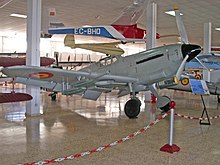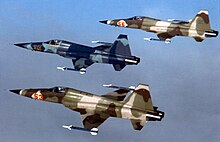Aerodynamic auxiliary surface





Aerodynamic auxiliary surfaces are used to reduce or increase steering forces, to bring the rudder into the correct position, to direct the air flow in a certain direction, to improve directional stability, to effect a targeted change of the boundary layer or to compensate for structural defects afterwards. From today's point of view, it is often a question of solutions to problems that are also associated with increased air resistance. Often these are components made of simple sheet metal. Only Strakes and the Flettner rudder have prevailed.
Types of aerodynamic auxiliary surfaces.
Auxiliary rudder
Auxiliary rudders (also trim rudders ) were used to reduce manual forces on control organs or to generate them. The picture of the Boulton Paul Overstrand shows an auxiliary rudder, which was attached far behind the rudder. The shape used today is the Flettner oar .
Flettner oars and anti-flettner
The Flettner rudder is a small control surface on the actual rudder which can be used to relieve the pilot's hand strength or to move the entire rudder. The auxiliary rudder, which is often referred to as anti-flettner, has exactly the opposite effect. B. simulates rudder pressure on a pressure-free pendulum horizontal stabilizer of a Robin DR 400 and specifies a certain felt neutral position of the rudder. On the Grob G-110 , too , the aileron forces were so low that the pilots found it uncomfortable. here, too, an anti-Flettner brought relief.
Stirrup edges
Bracket edges are metal strips on the rear edges of control surfaces that have the same task as Flettner rudders, but can only be adjusted on the ground.
Other aerodynamic surfaces to balance forces
The pictures of the Christen Husky and the Do X show different ways of balancing forces without the use of Flettner oars or stirrup edges. Even Alexander Lippisch built to the elevons of RRG Stork V subsequently auxiliary surfaces on which lay some distance behind the rudder trailing edge.
Strakes
Strake are elements drawn far forward at the transition between fuselage and wings or tail units. The purpose is to improve the aerodynamic effect of these components by specifically generating a vortex. A strake placed in front of the vertical stabilizer also changes the ratio of the projected side surfaces in front of and behind the center of gravity. With the P-51D Mustang and the P-47D Thunderbolt , for example, For example, after the introduction of the teardrop hoods, it was found that this ratio was no longer correct due to the elimination of the high back of the fuselage and the machines tended to lurch. The strakes solved this problem.
Keel fins
Keel fins , false keel , etc. are air guide surfaces that improve directional stability or spin behavior, generate a certain amount of yaw dampening, etc. They are also often retrofitted if stability deficiencies are found during flight tests . Keel fins can be attached centrally (simple fuselage) or double (often diverging in a V-shape) under the trunk. Variants are baffles placed on the horizontal stabilizer or mounted under the fuselage, e.g. B. when an aircraft is converted from wheeled undercarriage to floats, which negatively affect the directional stability. (e.g. DHC Beaver )
Boundary layer fences
A boundary layer fence serves to soften or prevent cross currents on the wing. This is especially true for swept-wing , although an improvement in the demolition of behavior can be observed even with unswept wings. The boundary layer fence was invented by Wolfgang Liebe and first tested on a Messerschmitt Bf 109 .
End plates
End caps are, so to speak, the forerunners of today's winglets or a boundary layer fence at the wing tip, which is intended to prevent the flow around the winglets and the associated loss of lift. In aircraft with double rudders and various tailless designs , a comparable effect occurs. In this context, one often speaks of end disk rudders .
Vortex generators
Elements in the form of small sheet metal angles, which are usually placed on the wings, are used to make the flow turbulent and thus energetic. (See turbulator )
Gurney Flap
Gurney Flaps are sheet metal strips on the rear edge of the profile, which have about 1–2% of the profile depth and are angled by 90 °. They increase lift considerably and are used primarily on the output surfaces of racing cars. Similar phenomena have been known for a long time. B. in the Bf 109K , the two oppositely twisted bow edges on the rudder caused a significantly better response of the rudder around the zero position.





